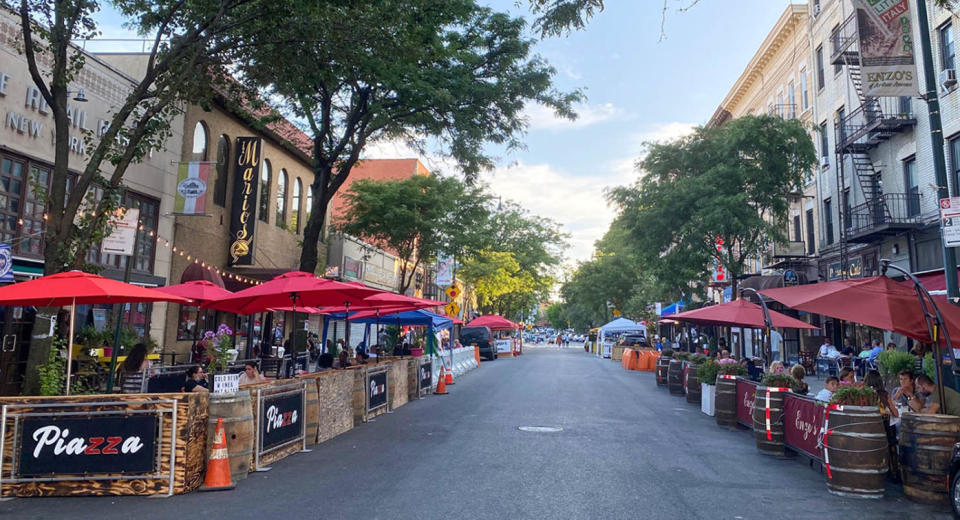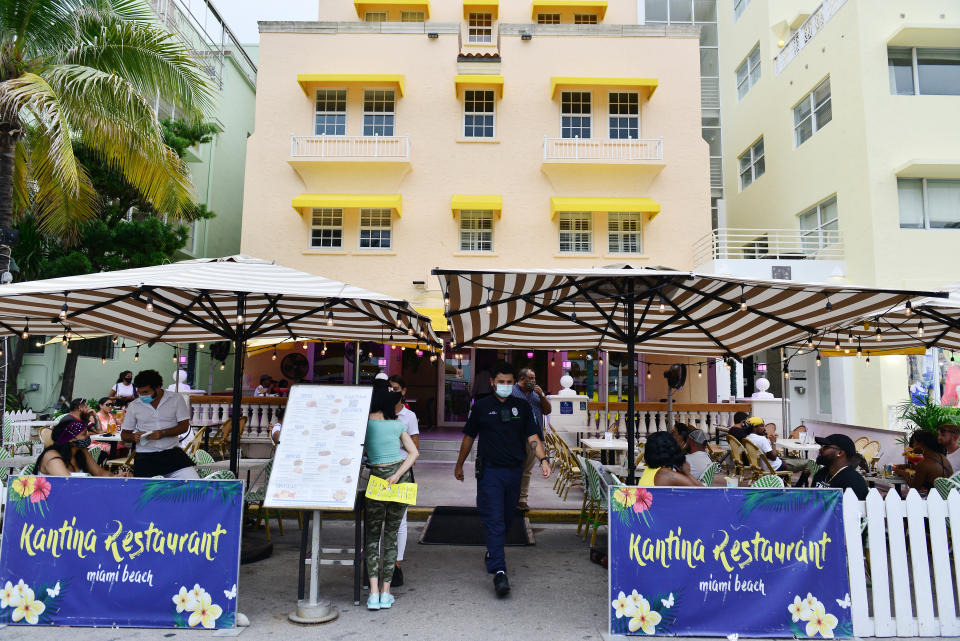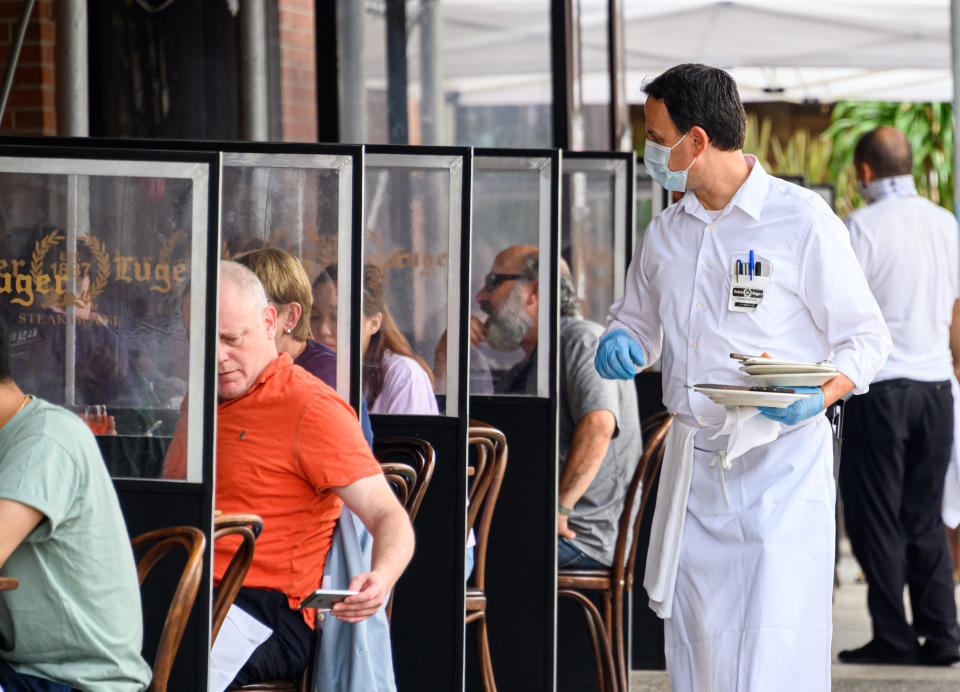New York speeds to open restaurants for indoor dining despite scientists' concerns over COVID-19 spread
WASHINGTON — Arthur Avenue in the Bronx is one of New York’s great culinary thoroughfares, long regarded as the city’s “true” Little Italy, both tastier and more authentic than its heavily touristed counterpart in lower Manhattan. Like every other segment of New York’s restaurant industry, Arthur Avenue was devastated by the coronavirus, which killed some 23,000 people in the city throughout the spring.
The summer provided a lifeline, with eateries turning the street into “Piazza di Belmont,” an open-air arrangement whose name refers to the surrounding neighborhood’s Italian heritage. (The artisans who lived here are responsible for the graceful masonry of the Bronx Zoo.) But that has barely proved sustaining, and now those restaurants are desperate to host diners indoors again, especially with cold weather looming.

“This is doable,” Peter Madonia, head of the Belmont Business Improvement District, told Brian Lehrer, a WNYC radio talk show host. Madonia, who owns a bakery on Arthur Avenue, added that waiting for a coronavirus vaccine to resume indoor dining, as Mayor Bill de Blasio suggested last week, is tantamount to a “death knell.”
New York Gov. Andrew Cuomo does have a plan to allow New York City restaurants to begin seating customers indoors at 25 percent capacity. But even though that plan — announced reportedly without de Blasio’s input, as the Democratic mayor and governor continue to feud — is relatively modest, it still flies in the face of science, with a new study from the Centers for Disease Control and Prevention suggesting that restaurants and bars are a significant source of viral transmission.
That study found that people infected with the coronavirus were twice as likely to have been at a restaurant than those who had not. And they were three times more likely to have frequented a bar.
“I am concerned about indoor dining, even at 25 percent capacity,” says Linsey Marr, a leading aerosol scientist at Virginia Tech who was not involved in the new CDC study. “Restaurants are the worst of all situations,” she says, because people don’t wear face masks while eating and drinking. They also tend to talk loudly, which is associated with increased pathogenic spread.
At the same time as New York City is opening restaurants for indoor seating, Florida is reopening bars to half capacity. Gov. Ron DeSantis, a Republican, has consistently downplayed and misrepresented the threat of the coronavirus.

Marr calls Florida’s move “unwise.”
For her own part, she says she has not been inside a restaurant since March and won’t eat at one until — in accordance with de Blasio’s now-discarded view — there is a vaccine. “I feel for the restaurants,” Marr says. Yet the evidence is clearly not on their side.
The new CDC study, published on Thursday, surveyed 314 adults across the nation in July. They had all gone for coronavirus testing after experiencing symptoms of COVID-19, the respiratory illness caused by the coronavirus. One hundred and sixty of those people turned out not to have COVID-19, while 154 did test positive for the disease. Those who contracted COVID-19, the new CDC study says, were “approximately twice as likely as were control participants to have reported dining at a restaurant in the 14 days before becoming ill.” They were also more likely to have visited a bar or coffee shop.
The study’s principal author, CDC epidemiologist Dr. Kiva Fisher, told Yahoo News that her study did not focus on the specifics of those restaurant outings. “We didn’t differentiate between indoor and outdoor dining,” she said, describing that as fertile ground for future study. A study by the Guangzhou Center for Disease Control and Prevention in China found that a person at a restaurant in Guangzhou infected nine other diners during lunchtime service indoors. Researchers attributed the spread to “strong airflow from the air conditioner.”
Fisher lives in Atlanta, where the CDC is based. Although the state’s Republican governor, Brian Kemp, has allowed restaurants to offer indoor seating, Fisher said she has continued to support local eateries by resorting to “lower-risk options” such as ordering takeout or delivery.
“Those are good options to support local businesses,” she said. Restaurateurs have argued that while delivery and outdoor dining have allowed them to survive the past several months, they desperately need to resume indoor seating in order to turn a meaningful profit. The lack of a new federal coronavirus relief package, which has fallen victim to partisan combat on Capitol Hill, only makes the situation more urgent.

As has been the case throughout the pandemic, the clash of economic needs and scientific realities has made for an untenable situation. Fisher’s study found that study subjects who did contract COVID-19, and who had gone to a restaurant before becoming sick, “were less likely to report observing almost all patrons at the restaurant adhering to recommendations such as wearing a mask or social distancing.”
The report’s primary limitation was the lack of specificity about whether people were indoors or out. By the time the study took place in July, most of the states in the survey — among them Utah, Colorado and Massachusetts — had begun to allow indoor dining to some degree.
“We need data that assess if this perceived risk is mostly associated with indoor dining,” wrote former Food and Drug Administration head Scott Gottlieb on Twitter.
Dining, especially indoors, presents unique challenges that, the study notes, are not associated with other activities, such as shopping. For one, eating and drinking with a mask is impossible. Even with social distancing mandates in place, restaurants could become coronavirus hot spots. That could prove especially true in New York City, where finding the hole in the wall that serves the best pizza or samosa has long been the object of the city’s culinary enthusiasts.
“Direction, ventilation, and intensity of airflow might affect virus transmission, even if social distancing measures and mask use are implemented according to current guidance,” Fisher and her co-authors write. Some restaurants have installed sophisticated air filters, but smaller eateries may not find that an affordable option.
“For indoor dining, ventilation is really key,” said Dr. Eric Feigl-Ding, an epidemiologist who has risen to prominence with his tweets about the disease. “There needs to be at least a very strong draft with completely open air if indoors, given the loud ambience of most restaurants.”

As with school reopenings, the lack of a national plan appears to have only fostered greater confusion. The CDC does offer guidance to restaurants, but it’s relatively broad, urging practices like washing hands and disinfecting surfaces. New York City’s plan for indoor dining also lacks specificity, though it does call for temperature checks and prohibits seating at bars.
Mayoral spokesperson Bill Neidhardt said it was untrue that de Blasio and Cuomo had clashed on how and when restaurants should reopen in the city. He said the two men, who have been political enemies for years, “worked on the same plan.”
The plan says that if the positivity rate on coronavirus diagnostic tests rises above 2 percent, “the city will immediately reassess.” That positivity rate, however, will be reflective of who in New York City goes for a coronavirus test on any given day, as opposed to a measure of infection rates among people dining at restaurants.
Feigl-Ding dismissed temperature checks as a largely cosmetic measure, since people can transmit the virus even without running a fever. And he was doubtful about the city’s quarter-capacity mandate. Even if a restaurant is only 25 percent full, he told Yahoo News, people “can still release lots of aerosols while shouting or talking for an hour.”
Cuomo’s office did not respond to a request for comment.
As the CDC study suggests, the brutal reality of the pandemic may be that keeping away from other people, difficult as it may be, remains the easiest way to prevent the virus from spreading. A new study from researchers at Johns Hopkins University published in the journal Clinical Infectious Diseases found that infection “was significantly less common in those who reported strict social distancing indoors and outdoors.” It also concluded that “consistent indoor mask use was significantly associated with a lower likelihood of infection.”

One of the study’s authors, Sunil Solomon, said he was troubled as he drove past a crowded outdoor patio in Washington, D.C. “There was clearly no social distancing,” he said of the restaurant in question, Millie’s, a popular Nantucket-themed eatery.
Though people were congregating on an open-air patio, Solomon said the scene was nevertheless concerning. “People lose inhibition after a couple of drinks,” moving closer and speaking louder, he said. At the same time, he understood the imperative to congregate at bars and restaurants, especially as autumn weather looms.
“All of us have been cooped up for months, and we are looking for some opportunity to go out,” he told Yahoo News. “We are getting to a point when people are fatigued.”
_____
Read more from Yahoo News:

 Yahoo Sport
Yahoo Sport 








































